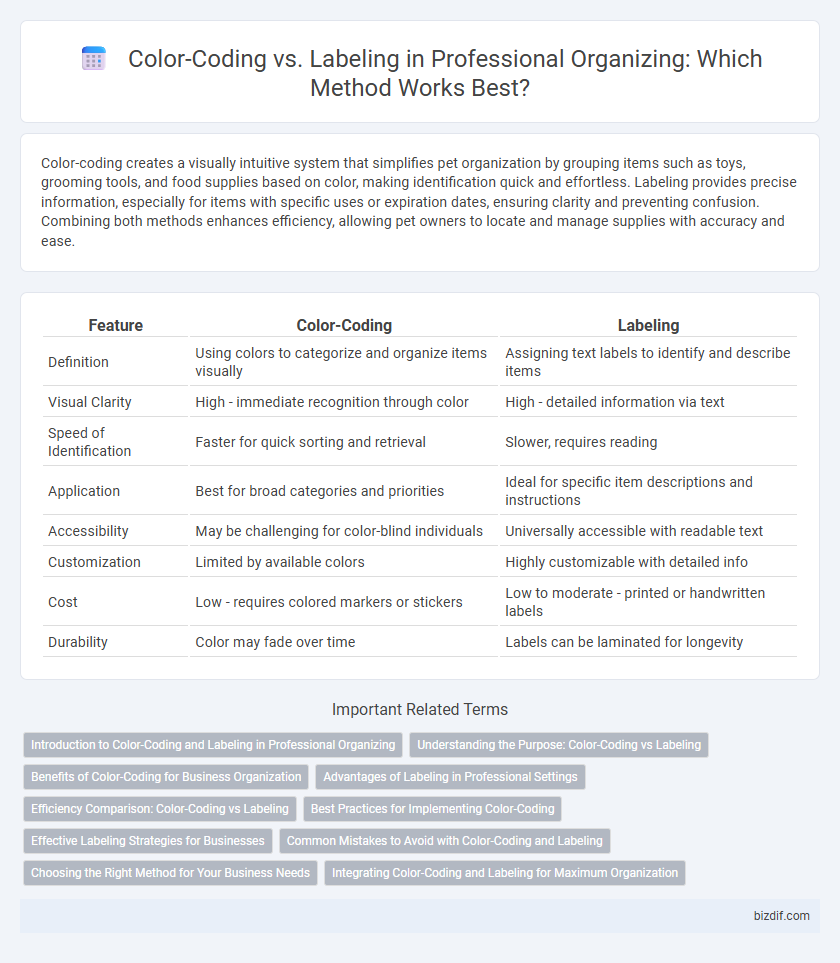Color-coding creates a visually intuitive system that simplifies pet organization by grouping items such as toys, grooming tools, and food supplies based on color, making identification quick and effortless. Labeling provides precise information, especially for items with specific uses or expiration dates, ensuring clarity and preventing confusion. Combining both methods enhances efficiency, allowing pet owners to locate and manage supplies with accuracy and ease.
Table of Comparison
| Feature | Color-Coding | Labeling |
|---|---|---|
| Definition | Using colors to categorize and organize items visually | Assigning text labels to identify and describe items |
| Visual Clarity | High - immediate recognition through color | High - detailed information via text |
| Speed of Identification | Faster for quick sorting and retrieval | Slower, requires reading |
| Application | Best for broad categories and priorities | Ideal for specific item descriptions and instructions |
| Accessibility | May be challenging for color-blind individuals | Universally accessible with readable text |
| Customization | Limited by available colors | Highly customizable with detailed info |
| Cost | Low - requires colored markers or stickers | Low to moderate - printed or handwritten labels |
| Durability | Color may fade over time | Labels can be laminated for longevity |
Introduction to Color-Coding and Labeling in Professional Organizing
Color-coding and labeling are essential techniques in professional organizing that enhance visual clarity and streamline item identification. Color-coding uses different hues to categorize belongings quickly, improving retrieval speed and reducing decision fatigue. Labeling complements this system by providing explicit textual information, ensuring accuracy and accessibility in organized spaces.
Understanding the Purpose: Color-Coding vs Labeling
Color-coding in professional organizing enhances visual recognition by assigning specific colors to categories, improving quick identification and reducing decision fatigue. Labeling provides precise information by naming contents, ensuring clarity and detailed understanding of items or sections. Both methods optimize organization efficiency, with color-coding supporting rapid sorting and labeling facilitating exact retrieval and inventory management.
Benefits of Color-Coding for Business Organization
Color-coding enhances business organization by increasing efficiency through quick visual identification of categories, reducing time spent searching for documents or items. Implementing color-coded systems streamlines workflows, improves accuracy in task management, and minimizes errors in inventory tracking. This method supports effective communication across teams by providing a consistent, intuitive reference system that boosts overall productivity.
Advantages of Labeling in Professional Settings
Labeling in professional organizing enhances clarity and efficiency by providing explicit identification, reducing search time and minimizing errors in busy environments. Unlike color-coding, labels accommodate a wider range of information, including detailed descriptions and instructions, which supports better compliance with organizational protocols. Clear labeling also facilitates communication across diverse teams and supports consistent inventory management in offices and storage areas.
Efficiency Comparison: Color-Coding vs Labeling
Color-coding increases efficiency by enabling quick visual identification, reducing the time needed to locate items, especially in large spaces or complex systems. Labeling provides detailed information that improves accuracy in item retrieval but may require more cognitive effort to read and interpret. Combining color-coding with clear labeling optimizes workflow by balancing speed and precision in organizing tasks.
Best Practices for Implementing Color-Coding
Effective professional organizing leverages color-coding to enhance visual categorization and streamline item retrieval. Best practices include using distinct, easily distinguishable colors assigned consistently to specific categories, ensuring labels complement colors with clear, descriptive text for added clarity. Combining durable, weather-resistant labels with a standardized color palette maximizes organizational efficiency and reduces confusion in diverse environments.
Effective Labeling Strategies for Businesses
Effective labeling strategies for businesses in professional organizing enhance productivity by ensuring quick identification and retrieval of materials, reducing errors and saving time. Unlike color-coding, which can be subjective and limit scalability, clear and consistent labels use specific keywords, standardized fonts, and durable materials to improve clarity and longevity. Incorporating QR codes or digital labels further optimizes inventory management and streamlines workflow in dynamic business environments.
Common Mistakes to Avoid with Color-Coding and Labeling
Common mistakes to avoid with color-coding and labeling include using too many similar colors that create confusion rather than clarity and applying labels that are too small or vague to read quickly. Neglecting consistency in color schemes and label formats can disrupt organization and reduce efficiency in locating items. Choosing non-durable materials for labels or failing to update color codes regularly also undermines the system's effectiveness over time.
Choosing the Right Method for Your Business Needs
Color-coding enhances visual recognition and speeds up item retrieval, making it ideal for businesses with high-volume inventory or quick-decision environments. Labeling provides detailed information and is essential for complex or varied product lines requiring precise identification and tracking. Selecting the right method depends on your business needs: opt for color-coding to streamline processes and labeling to ensure accuracy and clarity in organization.
Integrating Color-Coding and Labeling for Maximum Organization
Integrating color-coding and labeling enhances professional organizing by combining visual cues with clear identification, accelerating item retrieval and reducing clutter effectively. Using consistent colors linked to specific categories alongside precise labels minimizes confusion and streamlines space management, boosting productivity in both home and office environments. This dual approach supports cognitive recognition and efficient sorting, making organization intuitive and sustainable over time.
Color-coding vs Labeling Infographic

 bizdif.com
bizdif.com